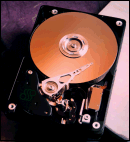| | Storage : Hard Disks |
|
Hard disks are magentic disks. They have much larger storage capacities than floppy disks. Data can be transferred to and from a hard disk much more quickly than from a floppy disk. Hard disks are usually fixed inside a computer and can not be moved between different machines. Some expensive hard disks can be moved between computers. These are called exchangeable hard drives. An example of this is the Jaz drive.
A hard disk is made of a rigid disk which is coated with a magnetisable material. The magnetic material used is of a much higher quality than that found on floppy disks. Hard disks spin much more quickly than floppy disks and the disk head is positioned very close to the disk (thousandths of a millimetre away). Because the disk head is positioned so close to the disk hard drives can easily be damaged by dust or vibration. Therefore the disk, the drive head and all the electronics needed to operate the drive are built together into a sealed unit. This picture shows a hard disk drive with the case removed.

Usually (as in the picture above) several physical disks are contained in one hard disk unit. Each disk is known as a platter. Typical hard disk capacities for a home PC now start at 80Gb and units storing up to 300Gb are available. If larger storage capacities are required then multiple hard drives can be combined. Using appropriate hardware or software many hard disks can be made to look like one very large hard disc to the user.
GCSE ICT Companion 04 - (C) P Meakin 2004